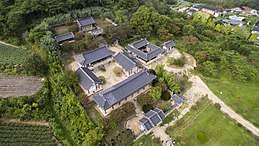Byeongsan Seowon
| UNESCO World Heritage site | |
|---|---|
 | |
| Location | Yecheon-myeon, Andong, North Gyeongsang Province, South Korea |
| Part of | Historic Villages of Korea: Hahoe and Yangdong |
| Criteria | Cultural: (iii), (iv) |
| Reference | 1324-002 |
| Inscription | 2010 (34th Session) |
| Area | 1.7 ha (4.2 acres) |
| Coordinates | 36°32′25″N 128°33′10″E / 36.54028°N 128.55278°ECoordinates: 36°32′25″N 128°33′10″E / 36.54028°N 128.55278°E |
| Korean name | |
| Hangul | 병산서원 |
| Hanja | 屛山書院 |
| Revised Romanization | Byeongsan Seowon |
| McCune–Reischauer | Pyŏngsan Sŏwŏn |
 Location of Byeongsan Seowon in South Korea | |
The Byeongsan Seowon is a seowon located in the neighborhood of Byeongsan-dong, Yecheon-myeon in the city of Andong, North Gyeongsang Province, South Korea. Seowon is a type of local academy during the Joseon Dynasty (1392–1897). It was first established as Jondeosa (尊德祠) by local Confucian scholars especially Jeong Gyeong-se (鄭經世) in 1613, the fifth year of King Gwanghaegung's reign, to commemorate the scholarly achievement and virtue of the notable Confucian scholar and politician Yu Seong-ryong. The predecessor of the seowon was Pungak Seodang (淵岳書堂) which was an educational institution located in Pungsan to teach the Pungsan Yu clan during the Goryeo period. Yu Seong-ryong moved the seodang to the current place in 1572.[1][2][3]

History
The history of Byeongsan Seowon began when Ryu Sung-ryong moved to Andong in 1572 from Pungak Seodang, an educational institution of Salim, from the Goryeo Dynasty. After Ryu Sung-ryong died in 1670, local Confucian spirits such as Chung Kyung-se founded Jongduk Temple in 1613 and enshrined its ancestral tablet to commemorate his academic work and virtues. It was renamed Byeongsan Seowon in 1614.
In 1620, following the public discussion by Eurim, the ancestral tablets were moved to Yeogang Seowon, which served Toegye teacher. In 1629, he prepared a separate memorial tablet to worship at Jongdeok Temple, and chose his third son Ryu Jin in addition. In 1863, he was transferred to the Academy of Seowon.
Byeongsan seongjeon served as a branch of local education to produce many scholars, and in 1868, Heungseon Daewongun ordered to remove it, but it was not damaged. The auditorium was rebuilt in 1921 in Japanese occupation. Hyangsarye is held in every March and September
It is designated as Historic Site No. 260 and contains about 3,000 books of about 1,000 different types, including Seo Ae's collection of books.[4]
See also
References
- ↑ "Byeongsan Seowon". www.byeongsan.net (in Korean). Retrieved 2018-04-28.
- ↑ Martin Robinson, Ray Bartlett, Rob Whyte (2007) "Korea" Lonely Planet, ISBN 1-74104-558-4 pp.220
- ↑ (in Korean) 병산서원 屛山書院 Archived 2011-06-10 at the Wayback Machine. Nate / EncyKorea
- ↑ "병산서원 : 서원소개". www.byeongsan.net.
External links
| Wikimedia Commons has media related to Byeongsan Seowon. |
- (in Korean) 병산서원(屛山書院) at Yesullo